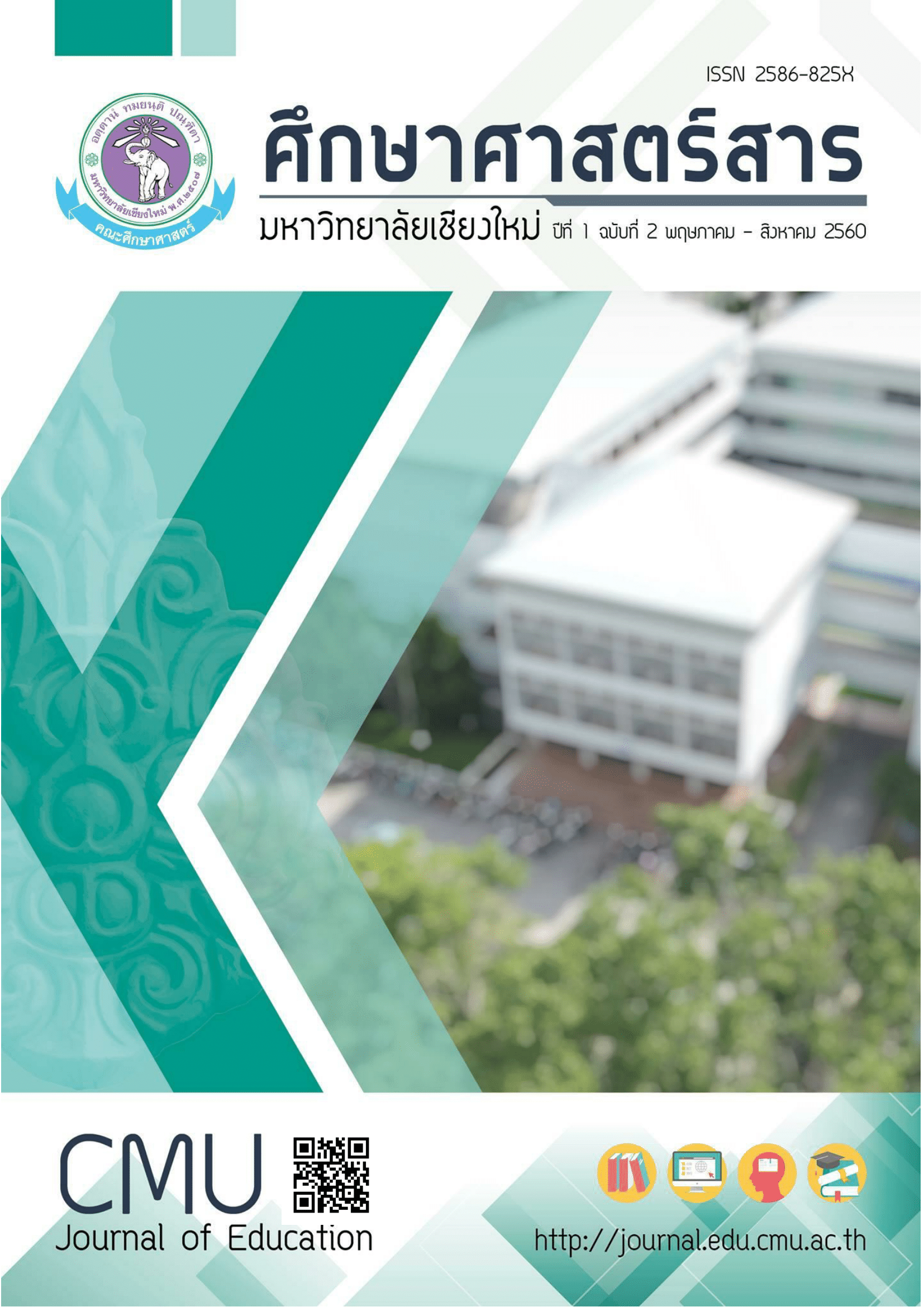ทฤษฎีความผันแปร: อีกมุมมองเกี่ยวกับการเรียนรู้
Main Article Content
บทคัดย่อ
บทความนี้นำเสนอแนวคิดเกี่ยวกับทฤษฎีความผันแปร ซึ่งมีรากฐานมาจากการวิจัยรูปแบบหนึ่งที่มีชื่อว่า “ปรากฏการณ์ภาพ” ทฤษฎีนี้อธิบายการเรียนรู้ด้วยมุมมองที่แตกต่างไปจากทฤษฎีสรรคนิยม ซึ่งเป็นกรอบแนวคิดหลักในการปฏิรูปการศึกษาของประเทศไทยในปัจจุบัน ในมุมมองของทฤษฎีความผันแปร คำว่า “การเรียนรู้” เพียงลำพังไม่มีความหมาย การเรียนรู้ต้องเป็นการเรียนรู้เกี่ยวกับบางสิ่งบางอย่าง (เช่น แนวคิด ปรากฏการณ์ หรือความสัมพันธ์) หรือที่ได้ชื่อว่า “วัตถุแห่งการเรียนรู้” ในขณะที่การเรียนรู้ในมุมมองของสรรคนิยมคือการเปลี่ยนแปลงโครงสร้างทางสติปัญญาของผู้เรียน แต่การเรียนรู้ในมุมมองของทฤษฎีความผันแปรคือการเปลี่ยนแปลงความสัมพันธ์ระหว่างผู้เรียนกับวัตถุแห่งการเรียนรู้ ในการนี้ ผู้เรียนต้องพัฒนาความสามารถในการมองเห็นลักษณะสำคัญต่าง ๆ ของวัตถุแห่งการเรียนรู้ การมองเห็นลักษณะสำคัญใด ๆ จะเป็นไปได้ ก็ต่อเมื่อผู้เรียนประสบความผันแปรของลักษณะสำคัญนั้นท่ามกลางลักษณะอื่น ๆ ที่ไม่ผันแปร เมื่อผู้เรียนมองเห็นลักษณะสำคัญทั้งหมดในเวลาพร้อมกันแล้ว ผู้เรียนจึงมีโอกาสพิจารณาความสัมพันธ์ระหว่างลักษณะสำคัญเหล่านั้น และเข้าใจวัตถุแห่งการเรียนรู้ได้อย่างสมบูรณ์ บทความนี้อภิปรายเพิ่มเติมว่า ทฤษฎีความผันแปรไม่ได้ขัดแย้งกับทฤษฎีสรรคนิยม หากแต่ให้อีกมุมมองหนึ่งเกี่ยวกับการเรียนรู้
Article Details
หากผู้เสนอบทความมีความจำเป็นเร่งด่วนในการตีพิมพ์โปรดส่งลงตีพิมพ์ในวารสารฉบับอื่นแทน โดยกองบรรณาธิการจะไม่รับบทความหากผู้เสนอบทความไม่ปฏิบัติตามเงื่อนไขและขั้นตอนที่กำหนดอย่างเคร่งครัด ข้อมูลของเนื้อหาในบทความถือเป็นลิขสิทธิ์ของ Journal of Inclusive and Innovative Education คณะศึกษาศาสตร์ มหาวิทยาลัยเชียงใหม่
เอกสารอ้างอิง
กระทรวงศึกษาธิการ. (2551). หลักสูตรแกนกลางการศึกษาขั้นพื้นฐาน พุทธศักราช 2551. เข้าถึงจาก https://www.kroobannok.com/news_file/p59087671156.pdf (24 เมษายน 2560).
ลือชา ลดาชาติ และ หวันบัสรี วาเด็ง. (2555). วิธีการแตกแรงของนักเรียนชั้นมัธยมศึกษาปีที่ 4: การวิจัยปรากฏการณ์ภาพ. วารสารสงขลานครินทร์ (ฉบับสังคมศาสตร์และมนุษยศาสตร์), 18(2), 193-226.
สำนักงานคณะกรรมการการศึกษาแห่งชาติ. (2545). พระราชบัญญัติการศึกษาแห่งชาติ พ.ศ. 2542 (แก้ไขเพิ่มเติม พ.ศ. 2545). กรุงเทพฯ: บริษัทพริกหวานกราฟฟิก จำกัด.
Allen, M. (2014). Misconceptions in Primary Science. Maidenhead: Open University Press.
Cai, J. and Nie, B. (2007). Problem Solving in Chinese Mathematics Education: Research and Practice. ZDM Math Educ, 39(5), 459-473.
Gu, L., Huang, R., and Marton, F. (2004). Teaching with Variation: A Chinese Way of Promoting Effective Mathematics Learning. In F. Lianghuo, W. Ngai-Ying, C. Junfa., and L. Shiqi. (Eds.). How Chinese Learn Mathematics: Perspectives from Insiders. (pp. 309-347). New Jersey: World Scientific
Guo, J. and Pang, M. F. (2011). Learning a Mathematics Concept from Comparing Examples: The Importance of Variation and Prior Knowledge. Eur J Psychol Educ, 26(4), 495-525.
Kullberg, A., Kempe, U. R., and Marton, F. (2017). What is Made Possible to Learn When Using the Variation Theory of Learning in Teaching Mathematics? ZDM Math Educ, 49, 559-569. doi:10.1007/s11858-017-0858-4.
Kullberg, A., Runesson, U., and Martensson, P. (2014). Different Possibilities to Learn from the Same Task. PNA, 8(4), 139-150.
Linder, C., Fraser, D., and Pang, M. F. (2006). Using a Variation Approach to Enhance Physics Learning in a College Classroom. Phys Teach, 44(9), 589-592.
Marton, F. (2015). Necessary Conditions of Learning. New York: Routledge Falmer.
Marton, F. and Booth, S. (1997). Learning and Awareness. New Jersey: Lawrence Erlbaum Associates.
Marton, F., Runesson, U., and Tsui, A. B. (2014). The Space of Learning. In F. Marton and A. B. M. Tsui. (Eds.). Classroom Discourse and the Space of Learning. (pp. 3-40). New Jersey: Lawrence Erlbaum Associates.
Organisation for Economic Co-operation and Development. (2014). PISA 2012: Results in Focus. Retrieved from https://www.oecd.org/pisa/keyfindings/pisa-2012-results-overview.pdf.
Organisation for Economic Co-operation and Development. (2016). PISA 2015: Results in Focus. Retrieved from https://www.oecd.org/pisa/pisa-2015-results-in-focus.pdf.
Pang, M. F. and Marton, F. (2005). Learning Theory as Teaching Resource: Enhancing Students’ Understanding of Economic Concepts. Instr Sci, 33(2), 159-191.
Pang, M. F., Marton, F., Bao, J., and Ki, W. W. (2016). Teaching to Add Three-Digit Numbers in Hong Kong and Shanghai: Illustration of Differences in the Systematic Use of Variation and Invariance. ZDM Math Educ, 48(4), 455-470.
Posner, G. J., Strike, K. A., Hewson, W., and Gertzog, W. A. (1982). Accommodation of a Scientific Conception: Toward a Theory of Conceptual Change. Sci Educ, 66(2), 211 – 227.
Runesson, U. (2005). Beyond Discourse and Interaction. Variation: A Critical Aspect for Learning and Learning Mathematics. Cambridge Journal of Education, 35(1), 69-87.
Sun, X. (2011). “Variation Problems” and Their Roles in the Topic of Fraction Division in Chinese Mathematics Textbook Examples. Educ Stud Math, 76(1), 65-85.
Sun, X. (2013). The Fundamental Idea of Mathematical Task Design in China: Origin and Development. Retrieved from https://www.mathunion.org/fileadmin/ICMI/files/text_-chinese_variation_theory-final-1.pdf.
von Glasersfeld, E. (1995). Radical Constructivism: A Way of Knowing and Learning. New York: Routledge Falmer.
Vygotsky, L. S. (1978). Mind in Society: The Development of Higher Psychological Processes. Cambridge: Harvard University Press.
Watson, A. and Mason, J. (2006). Variation and Mathematics Structure. Math Teach, 194, 3-5.


